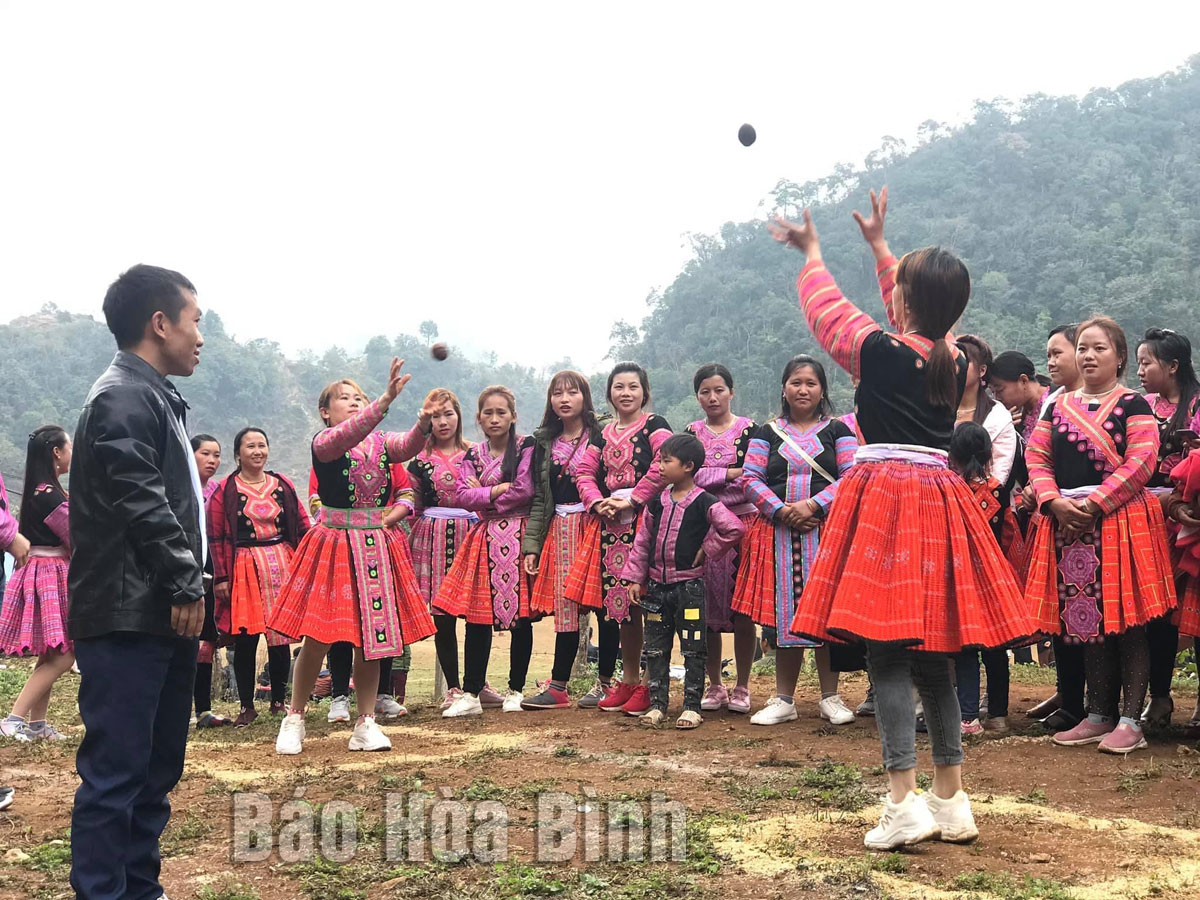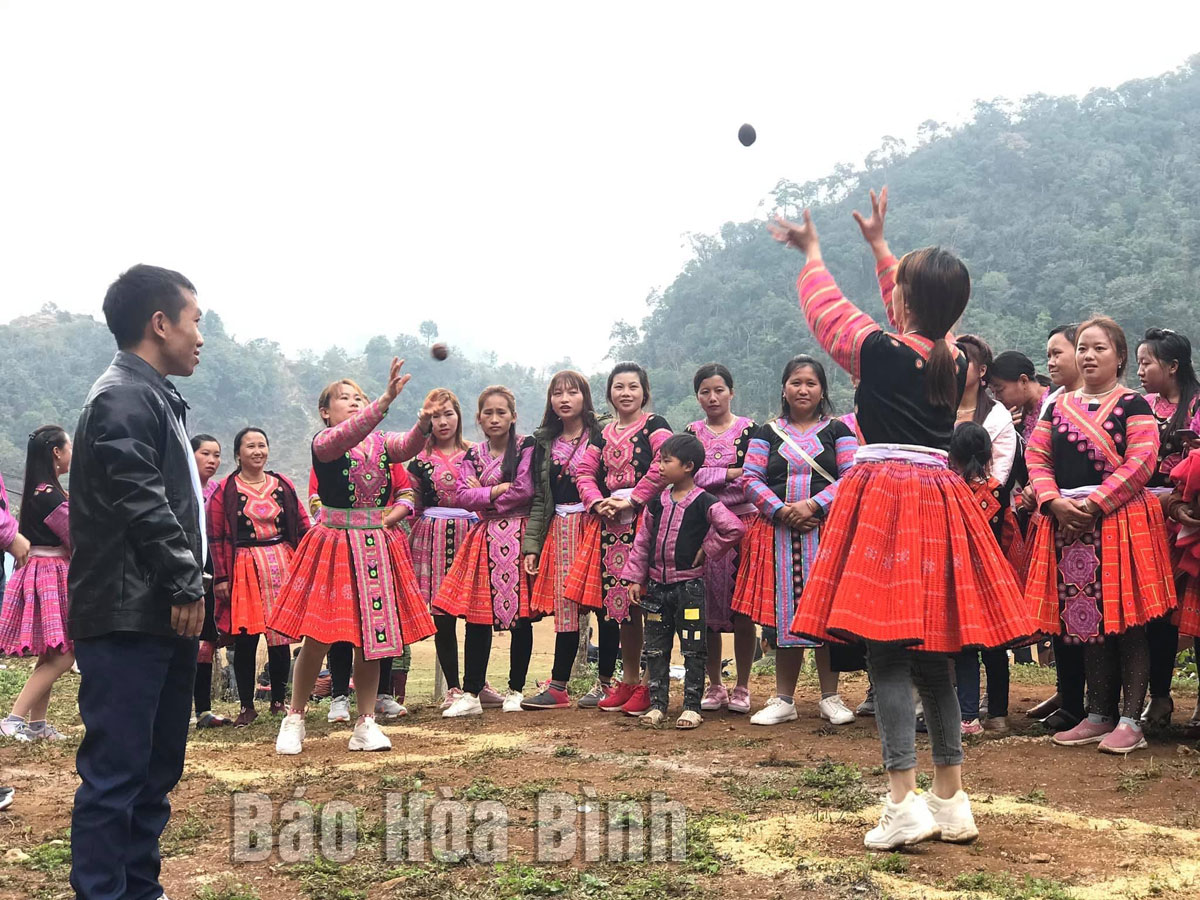
(HBO) – An interesting cultural relic of the Mong ethnic group in the northwestern region of Vietnam is that of the "ném pao” or ball throwing. It is not merely a folk game but represents much more to the ethnic traditions of the Mong. Nem Pao is a unique form of partnership and happiness that can lead to much more for ethnic Mong couples.

Mong ethnic women in Hang Kia commune,
Mai Chau district are throwing the ball (Nem Pao) on a spring day.
Images of Mong women busily sewing the last stiches on clothes and colourful
pao flow into the spotlight as visitors drop by the Hang Kia and Pa Co communes
in Mai Chau district. Colourful pao is made from linen cloth, stuffed with
flaxseed. According to Mong ethnic beliefs, the linen and flax balls are
colorful symbols of happiness and represent fertility and future partnership
within the community.
Pao making has been passed down through generations. Trumpet and khen (pan-pipe)
dances help men to find their partner, and pao are the equivalent symbol of
partnership for women.
A simple game, pao throwing carries great cultural value in that it allows men
and women to introduce and meet each other around the pao symbol of happiness.
The cultural phenomenon results in couples first meeting and transitioning into
becoming husbands and wives.
According to Sung Thi Mua, a local in Hang Kia hamlet, Hang Kia commune, it is
the Mong ethnics’ tradition that women should yield their paos in the spring to
start a season of fertility and partnership.
"We are passing down the making of pao and ball throwing festivities to younger
generations, and in doing so, perpetuate the Mong cultural traditions”, Mua
said.
Sung Y Mai, a brocade weaving artisan in Hang Kia commune, said Mong men want
to marry a woman who is good at weaving, embroidery and sewing pao.
"A good Mong woman must know how to make a good pao”, she said, explaining a
good pao must have tight stitches and it should be the perfect shape.
Nem
Pao is held at the yard of the local cultural houses or at the pitch, during
which two teams, each with three-to-ten men or women, throw the linen ball and
ensure it does not fall to the ground. While playing, women and men exchange
glances, smiles, and affection. After the game, if the woman and man feel the
love, the man will keep her pao and express his admiration on a subsequent
visit to her home. The goal, of course, is a lifelong partnership between them,
based on sewing skill and enjoying the cultural festivities together.
Nowadays,
life in Mong villages has changed drastically. The Mong people are paying due
attention to preserving their cultural values by integrating traditional games
into extra-curricular activities at the local schools.
According to Vang Y Sai, a teacher of Hang Kia Primary and Secondary School, in
a bid to preserve and develop folk games, the school carries out a wide range
of measures to encourage both students and parents to join folk games on regular
afternoons.
Together with ball throwing, other folk games like "đánh yến” (rooster feather
shuttlecocks), tu lu (traditional version of spinning tops), "đẩy gậy” (stick
pushing) and "ném còn” (còn throwing) have been well preserved by the Mong
ethnic in Mai Chau.
The games are not only a vivid illustration of Mong men’s strength and bravery
and the skillfulness of Mong women, but they also raise hope for a happy and
prosperous life./.
Xoe dance, an unique art form of the Thai ethnic minority group in Mai Chau district of Hoa Binh province has existed for a long time and passed down through generations. Xoe dance is not only a popular dance in the Thai community but also a unique cultural feature, an indispensable part in the Thai ethnic minority people's cultural and spiritual life.
The Bac Son pre-school in Hung Son commune, Kim Boi district is effectively implementing a model of preserving and promoting cultural identity of the Muong ethnic group.
Through ups and downs, many unique cultural features of the Muong ethnic minority group are facing risks of falling into oblivion. However, with a strong determination, Lac Son district of Hoa Binh province has deployed synchronous solutions to preserve and promote the locality's cultural heritage values.
If Tan Lac is considered the core of the cradle of Muong culture in Hoa Binh, Phong Phu commune is the cultural centre of Muong culture in Tan Lac district. Luy Ai hamlet in Phong Phu commune is where customs and traditions of Muong Bi are preserved. Luy Ai hamlet was chosen to build a space to preserve Muong ethnic culture. The district is seeking support from the province and coordinating with relevant agencies to devise a plan on preservation of Muong cultural spaces associated with developing tourism products and improving the lives of local residents.
Nguyen Manh Tuan, a Muong ethnic man in Ba Hang Doi town, Lac Thuy district, is known as a young, dedicated, and outstanding artisan who has made significant contributions in collecting, restoring, and preserving national cultural values.
The Government Office with Document No. 2082/VPCP-KGVX, dated March 29, 2024, sent out the opinion of Deputy Prime Minister Tran Hong Ha regarding the submission of the "Mo Muong" and "Cheo art" dossiers to the United Nations Educational, Scientific and Cultural Organization (UNESCO).



